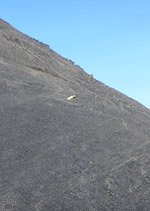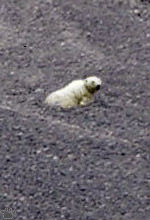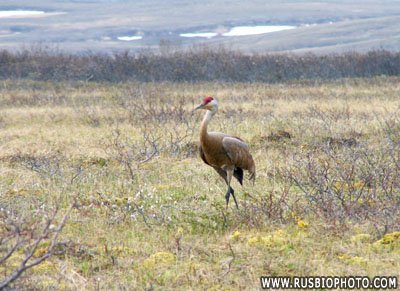|
From
a rearranged translation of Vladimir
Dinets original pages to norwegian,
with supplements.

Klikk på flagg for norsk versjon
Chukotka
When Russians say "Siberia", they usually refer only
to the inland areas of Asian Russia. All Pacific Coast, from Chukchi
Sea
to Ussuriland, is called "The Far East", or RFE. This
part is much more interesting for a naturalist or a tourist than
Siberia itself.
Thanks to milder climate and less violent glacial history, RFE
shelters the most diverse flora and fauna in the country.
Still, the forces of Nature are no less savage here than in Siberia.
Typhoons, tsunamis, volcanoes and snowstorms have created
some of the world's most beautiful landscapes. There are only
a few big cities in RFE, so in most areas the environment is in
better condition than elsewhere in Asia. In some parts, native
peoples are still the only source of environmental impact,
and their numbers are steadily declining, mostly due to assimilation
and emigration from tribal lands. |
|
|
There are some good biologists in RFE, and
hundreds of expeditions have
been working there in the last 150 years. But the Nature of
RFE is so
diverse that you can start making small discoveries the moment
you step
off the airplane.
In 1991, I found a colony of Aleutian terns within one mile
from the city airport
of Anadyr, the capital of Chukotka. This colony was the first
ever found that
far north. Climate change results in growing influx of southern
species,
especially birds, so now the Aleutian tern has become much more
common
and widespread than 16 years ago.
|
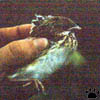 Lapland
longspur chick, Anadyr
Lapland
longspur chick, Anadyr
|
The Aleutian tern
breeds only in Alaska and eastern Siberia, nesting coastally in
dispersed colonies (North 1997). Their
breeding range extends from southeast Alaska to the western Aleutian
Islands and as for north as the Chukchi Sea.
In Russia they breed in the Bering Sea, Sea of Okhotsk and the
Kamchatka Peninsula. |

Map from USGS
More
text here
The
city of Anadyr is situated in the mouth of Anadyr River. The river
flows from mysterious and beautiful Elgygytgyn Lake in
an ancient impact crater, then crosses uninhabited mountains and
willow-covered plains. Thousands of seals
and dolphins
enter the river every summer, chasing salmon and herring. Lapland
longspurs, Calcarius lapponicus, and especially
snow buntings,
Plectrophenax nivalis, are common town birds.
Recently, they've been joined by dusky thrushes, Turdus
eunomus, house
martins, Delichon urbica,
and house sparrows,
Passer domesticus. |
Dusky
Thrush, Turdus eunomus
 Dusky
Thrush. Tsukuba, Japan, 2007
Dusky
Thrush. Tsukuba, Japan, 2007
Source: http://en.wikipedia.org/wiki/File:Tsugumi1.JPG
The Dusky Thrush, Turdus eunomus, is
a member of the thrush family Turdidae which
breeds eastwards
from central Siberia. It is closely related to the more
southerly breeding Naumann's Thrush, Turdus. naumanni;
the two have often been regarded as conspecific.
This species breeds in open woodland areas, but unlike
Naumann's Thrush, Turdus naumanni, , Dusky Thrush
is more tolerant of mountainous and tundra-edge habitats.
This species is strongly migratory, wintering south
to southeast Asia, principally in China and neighbouring
countries. It is a rare vagrant to western Europe.
Source: http://en.wikipedia.org/wiki/Dusky_Thrush |
Lapland
Bunting, Calcarius lapponicus

Lapland
Bunting, Calcarius
lapponicus
Courtesy: USFWS

© http://www.ecosystema.ru/
The
Lapland Longspur or Lapland Bunting, Calcarius
lapponicus, is a passerine bird in the longspur
family Calcariidae, a group separated by most modern
authors from the Fringillidae (Old World finches).
It breeds across Arctic Europe and Asia and in Canada
and the northernmost USA. It is migratory, wintering
in the Russian steppes, the southern USA, Northern Scandinavian
arctic areas and down to coastal Southern Sweden, Denmark
and Great Britain.
The Lapland Longspur is a robust bird, with a thick
yellow seed-eater's bill. The summer male has a black
head
and throat, white eyestripe, chestnut nape, white underparts,
and a heavily streaked black-grey back.
It breeds in wet areas with birch or willow, and or
bare mountains, and winters on cultivated land or coasts.
The bird is often seen close to the tree line, and likes
to feed in mixed-species flocks in winter. Its natural
food consists of insects
when feeding young, and otherwise seeds. The nest is
on the ground. 2-4 eggs are laid. |
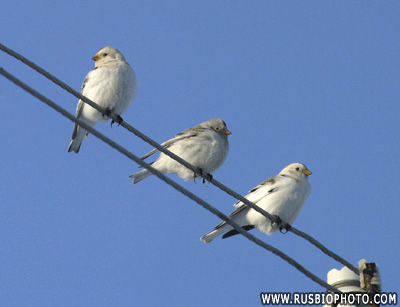 
Lapland
Longspur, Plectrophenax nivalis
©
www.ecosystema.ru/
|

Blooming diapensia, Diapensia lapponica ssp. obovata, Belyaka
Spit, Chukotka, Russia.
This is a wonderful part of the world. There are 220 bird
specimens, 59 mammals, 37 on the ground
and the other 22 are whales and seals. 10 whale specimens are
to be seen regularly within the coasts of Chukotka:
Grey
whale, Echrichtius robustus,
Bowhead
whale, Balaena / Eubalaena mysticetus,
Humpback
whale, (1)
Megaptera novaeangliae,
Finhval, Balaenoptera physalis,
Sei
whale, (1),
Balaenoptera borealis,
Minke
whale, (1),
Balaenoptera acutorostratus,
Blue
whale, Balaenoptera musculus,
Beluga - White whale,
(1), Delphinapterus leucas,
Killer
whale, (1),
(2), Orcinus
orca,
Narhval,
(1),
Monodon monoceros.
Of those the Nar whale, grey whale and Humpback whale
the most common visitors.
See
our whale page
here.
|
Nearly 80% of the total numbers of Icebear,
Urus maritimus,in the Bering Sea and Chukchi Sea
have caves and give birth to the youngsters on Wrangel- or Herald
Islands. About half of the world's
Pacific walrus, Odobeus rosmarus
divergens, often visits places along the coast. |

Summer
view of
Bering Sea from
Cape Kriguigun, Chukotka.. |
Wedged between Bering and Chukchi Seas, Chukotka (Chukchi
Peninsula)
is one of the most interesting places in the North.

Ringed seal, Ph. hispida hispida, and bearded seals,
off Chukotka.
.
It has the highest biodiversity in the Arctic, both on land
and in the sea.
Some marine mammals occur in huge numbers here.
|
. |
 |
 |
|
Juvenile
ringed seals, Russkaya Koshka Spit, Chukotka
|
Northern
Fur Seal, Callorhinus ursinus, Harbor
seal or Common
seal, Phoca vitulina, og Spotted
seal, Phoca larga,
are common in the souther part of Bering Sea ; Harlekinseal
or Ribbon Seal, Phoca fasciata, Ringed
seal , Phoca hispida,
Pacific Blue seal (?), Erignathus barbatus (nauticus),
and Spotted seal, Phoca largha
are to be found in more northernly waters.
The threatened Steller'
Sealion, Eumetopias jubatus, is also
still living in the western Bering Sea.. |
|
|
Polar
bears, Ursus maritimus, are common on the mainland
in winter, but very rare in summer.
Left:
Polar bear summering on a
mountaintop, Egvenkinot, Chukotka. .
Right:
Polar bear summering on a
mountaintop, Egvenkinot.
|
|
Spotted
seal,
Phoca largha
Larga seal / Spottet seal

Spotted
seal, Anadyr. |
Spotted seal is very common in southern
Chukotka
|

Spotted
seal, Anadyr. |

Spotted
seal, Anadyr. |
The Spotted seal prefers protected bays
and river mouths.
|

Minke whale,
Balaenoptera acutrostrata,
Belyaka Spitt. |
More
about the Spotted seals, click here
All those animals, with a few exceptions, are dependent of the
fish in Chikotka; In the Bering Sea there are alone more
than 450 fish and crustacean specimens..Here you may find 5
different species of the Pacific Salmon: Oncorhynchus
The Chinook salmon, Oncorhynchus tshawytscha,
is the largest species in the pacific salmon family.
Then come Coho or Silver Salmon, Oncorhynchus
kisutch, Sockeye salmon, Oncorhynchus nerka,
Chum or Keta salmon, Oncorhynchus keta,
and Pink salmon or Humpback salmon, Oncorhynchus
gorbuscha.
Chukotka naturally also have large river- and lake fisheries.
Pacific Salmon. Oncorhynchus is a genus of fish
in the family Salmonidae; it contains the Pacific salmons and
Pacific trouts.
The name of the genus is derived from the Greek onkos ("hook")
and rynchos ("nose"), in reference to the hooked jaws
of
males in the mating season (the "kype").
Salmon and trout with ranges generally in waters draining to
the Pacific Ocean are members of the genus.
Their range extends from Beringia southwards, roughly to Japan
in the west and Mexico to the east. In North America, |
Coho
salmon, Oncorhynchus kisutch
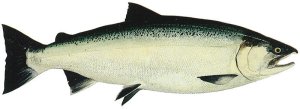  Drawing
of male ocean phase Coho and freshwater phase Coho (silver)
salmon (Oncorhynchus kisutch) (USFG)
Drawing
of male ocean phase Coho and freshwater phase Coho (silver)
salmon (Oncorhynchus kisutch) (USFG)
The Coho salmon, Oncorhynchus
kisutch, is a species of anadromous fish in the
salmon family.
Coho salmon are also known as silver salmon or "silvers".
It is the state animal of Chiba, Japan.
During their ocean phase, Coho have silver sides and
dark blue backs. During their spawning phase, the jaws
and
teeth of the coho become hooked. They develop bright
red sides, bluish green heads and backs, dark bellies
and
dark spots on their backs after they go in to fresh
water. |
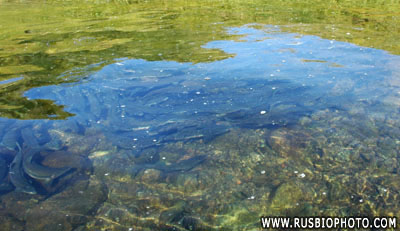 Ping
Salmon ,
Oncorhynchus gorbuscha
©
www.ecosystema.ru/
Ping
Salmon ,
Oncorhynchus gorbuscha
©
www.ecosystema.ru/
 Drawing
of a Pink salmon
Drawing
of a Pink salmon
Courtesy: U.S. Fish and Wildlife Service
Pink salmon or Humpback salmon,
Oncorhynchus gorbuscha, is a species of anadromous fish
in the salmon family.
It is the smallest and most abundant of the Pacific
salmon.
In the ocean, pink salmon are bright silver fish. After
returning to their spawning stream, their coloring changes
to pale grey
on the butt with yellowish white belly (although some
turn an overall dull green color).
During their spawning migration, males develop a pronounced
humped back, hence their nickname "humpies".
Pink salmon average 2.2 kg in weight. The maximum recorded
size was 76 cm and 6.8 kg.
Source: http://en.wikipedia.org/wiki/Pink_salmon |
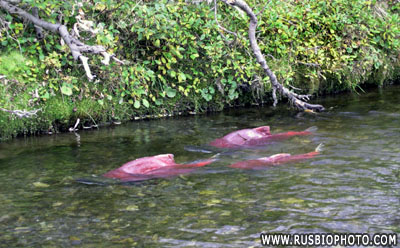 Sockeye
salmon or Red Salmon,
Oncorhynchus nerka
Sockeye
salmon or Red Salmon,
Oncorhynchus nerka
©
www.ecosystema.ru/
Sockeye salmon, Oncorhynchus
nerka, also called red salmon or blueback salmon
in the USA, is an anadromous species of salmon found
in the Northern Pacific Ocean and rivers discharging
into it. There are also completely landlocked populations
of the same species, which are known as kokanee or "silver
trout." Sockeye salmon is the third most common
Pacific salmon species.
Its name in Halkomelem, the language of the indigenous
people along the lower reaches of the Fraser River (one
of British
Columbia's many native Coast Salish languages). Suk-kegh
means red fish.
Source: http://en.wikipedia.org/wiki/Sockeye_salmon |
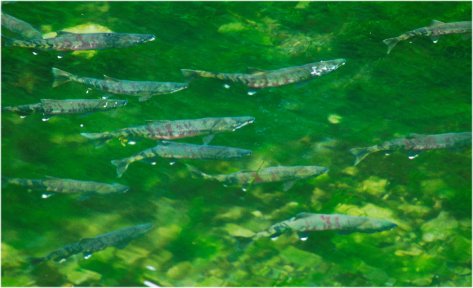 Chum
Salmon, Oncorhynchus keta
Chum
Salmon, Oncorhynchus keta
Photo: David Sepp, NOAA
The Chum or Keta salmon, Oncorhynchus
keta, is a species of anadromous fish in the salmon
family. It is a Pacific salmon, and may also be known
as dog salmon or Keta salmon, and is often marketed
under the name Silverbrite salmon
.
The name Chum salmon comes from the Chinook Jargon term
tzum, meaning "spotted" or "marked",
while "Keta" comes
from the Evenki language of Eastern Siberia via Russian.
They have an ocean coloration of silvery blue green.
When adults are near spawning, they have purple blotchy
streaks near
the caudal fin. Spawning males typically grow an elongated
snout or kype and have enlarged teeth. Some researchers
speculate these characteristics are used to compete
for mates.
Most Chum salmon spawn in small streams and intertidal
zones. Some Chum travel more than 3,200 km (2,000 mi)
up the
Yukon River. The female lays eggs in the redd, the male
sprays sperm on the eggs, and the female covers the
eggs with gravel. The female can lay up to 4000 eggs.
Source: http://en.wikipedia.org/wiki/Chum_salmon |
|
Thousands of migratory birds travel from wintering grounds
in the Americas, Asia,
and Europe to breed and feed in the region. Seabirds and waterfowl,
which form huge bird
colonies along the rocky shores, islets, sandy spits, and estuaries,
include nearly 3.3 million
seabirds on the eastern coast of Chukotka peninsula alone..
Amongst those are the Pelagic Cormorants, Phalacrocorax pelagicus,
guillemots, Cepphus,
murres, Uria, auklets, Aethia, puffins, , Fratercula, seagulls,
Larus, various ducks and waders...
|
Pelagic
Cormorant, Phalacrocorax pelagicus,

Pelagic
Cormorant on a nest with chicks that are about four weeks
old, in San Luis Obispo, California,
Source: http://en.wikipedia.org/wiki/File:Phalacrocorax_pelagicus_-San_Luis_Obispo,_California,_USA_-nest-8_(3).jpg
The Pelagic Cormorant, Phalacrocorax pelagicus,
also known as Baird's Cormorant, is a small member of
the cormorant family Phalacrocoracidae. Analogous to
other smallish cormorants, it is also called Pelagic
Shag occasionally. This seabird lives along the coasts
of the northern Pacific; during winter it can also be
found in
the open ocean.
The Pelagic Cormorant (Phalacrocorax pelagicus), also
known as Baird's Cormorant, is a small member of the
cormorant family Phalacrocoracidae. Analogous to other
smallish cormorants, it is also called Pelagic Shag
occasionally. This seabird lives along the coasts of
the northern Pacific; during winter it can also be found
in the open ocean.
Presently, many authors favor splitting up the "wastebin
genus" Phalacrocorax. In this case, the Pelagic
Cormorant would probably be placed in Compsohalieus.
On land, Pelagic Cormorants are rather clumsy and walk
with the high-stepped waddling gait typical for all
Sulae except darters; after landing they often scratch
the ground, as is typical for cormorants. When they
feel threatened, they will dart the bills at the intruder,
and shake their heads and make a gargling noise. This
bird forages by swimming to locate prey, then diving
and going after it underwater, propelled by its feet
and steering with the wings. It can dive as deep as
100 ft (30 m) to feed on or near the seafloor.
Source: http://en.wikipedia.org/wiki/Pelagic_Cormorant |
|
Long-tailed
Duck or
Oldsquaw, Clangula hyemalis
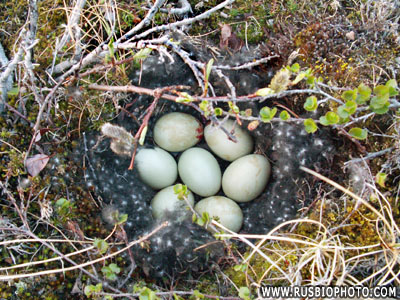
Think
we were just out a little to early to get a picture of the
chicks.
Havelle,
Clangula hyemalis
©
www.ecosystema.ru/
The Long-tailed Duck or Oldsquaw, Clangula
hyemalis, is a medium-sized sea duck. It
is the only living member of its genus, Clangula; this
was formerly used for the goldeneyes, with the Long-tailed
Duck being placed in Harelda.
Adults have white underparts, though the rest of the
plumage goes through a complex moulting process.
The male has a long pointed tail (10 to 15 cm) and a
dark grey bill crossed by a pink band. In winter, the
male has a dark
cheek patch on a mainly white head and neck, a dark
breast and mostly white body. In summer, the male is
dark on the head,
neck and back with a white cheek patch. |
 The
Long-tailed Duck.
The
Long-tailed Duck.
Foto: B. Frantzen/Norsk Polarinstitutt
Their breeding habitat is in tundra pools and marshes,
but also along sea coasts and in large mountain lakes
in the North Atlantic region, Alaska, northern Canada,
northern Europe and Russia. The nest is located on the
ground near water;
The Long-tailed Duck breeds often in or near Arctic
Tern colonies, and benefit of the terns defenceabilities
for the Arctic
fox,
Gulls
and Skuas.
Source:
http://en.wikipedia.org/wiki/Long-tailed_Duck |
|
Mammals of lowland tundra are usually difficult to see, but
Arctic ground squirrels are very tame and often live in towns.
Other mammals living on the arctic tundra includes brunlemen,
Lemmus trimucronatus, and arctic
lemming, Dicrostonyx torquatus, arctic
Fox, Alopex lagopus, snowy
owls, Nyctea scandiaca, Rock
Ptarmigane, Lagopus mutus(muta),
Snow Goose, Chen caerulescens, all kinds of eiders, Somateria,
Long tailed ducks, Clangula hyemalis, (see
above)
different seagulls,
Larus og snipes, Calidris, skuas,
Catharacta, snow
buntings , Plectrophenax nivalis,
og Lapland Longspur , Calcarius
lapponicus. |
Arctic
Lemming , Dicrostonyx torquatus
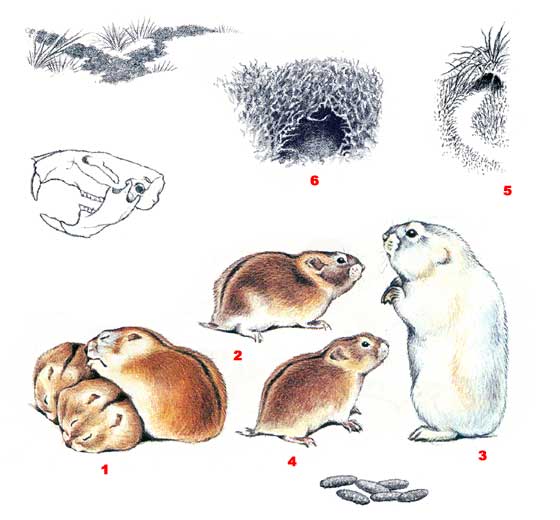
Arctic
Lemming , Dicrostonyx torquatus
© http://www.ecosystema.ru/
The Arctic Lemming, Dicrostonyx torquatus is
a species of rodent in the family Cricetidae.
It is found only in The
Arctic Biomes in Russia and Canada.
Inhabits arctic and subarctic tundra and forest-tundra
with small Salix spp. bushes. Lives in colonies with
simple burrows
along feeding routes; nesting and seed storage chambers
used collectively. Activity is multiphase and may occur
around
the clock. Feeds on shoots and leaves of willows and
birches, and vegetation and berries of cloudberry, great
bilberry
and other species. Litters 2-3 times a year with 5-6
young each time. A migratory species.
Source: Tsytsulina,
K., Formozov, N. & Sheftel, B. 2008. Dicrostonyx
torquatus. In: IUCN 2011. IUCN Red List of Threatened
Species. Version 2011.2. <www.iucnredlist.org>.
Downloaded on 24 February 2012. |
|
.
Subarctic
tundra.
Chukotka’s subarctic tundra has more vegetation than the
more northern tundra, and the river valleys
contain sparse larch stands, willow and poplar forests in riparian
areas, and birch. Here plant cover is almost continuous,
interrupted only on steep or windswept slopes. Diverse grass
beds rich in lichen, prime feeding grounds for reindeer,
cover the uplands. However, the myriads of insects are also
here..... |
 Grey
wolf, Canis lupus
©
www.ecosystema.ru/
Grey
wolf, Canis lupus
©
www.ecosystema.ru/
Normally you will find such animals as grey
wolf, arctic wolf ,Canis lupus, stout,
Mustela erminea,
hare, Lepus
timidus, Arctic
ground squirrel, Spermophilus parryi, wood
lemmings, Myopus schisticolor,
brown lemmings, Lemmus sibiricus,
voles, Microtus, raven,
Corvus corax, 1,
Rock
Ptarmigane, Lagopus lagopus,
Sandhill crane,
Grus canadensis, Greater
White-fronted Goose, Anser albifrons, bean
goose, Anser fabalis,
ducks,
Anas, seagulls, Larus, Alaskasnipe, Calidris
melanotos, polarsisik,
Acanthis/Carduelis hornemanni,
snowbuntings
and lapland longspurs, Plectrophenax nivalis. |
©
www.ecosystema.ru/
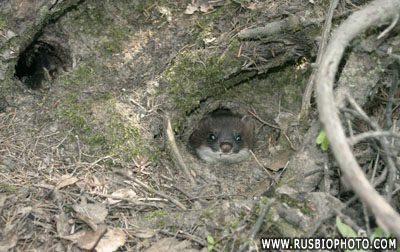  Wonder
who or what scared this one?
(Stout) Hare,
Lepus timidus
©
www.ecosystema.ru/
Wonder
who or what scared this one?
(Stout) Hare,
Lepus timidus
©
www.ecosystema.ru/
 Sibirian
brown lemming
Sibirian
brown lemming
Lemmus sibiricus,
Pohodsk, Yakutia |
The Siberian Brown Lemming, Lemmus sibiricus
is a species of rodent in the family Cricetidae.
It is found in Canada, Russian Federation, and United States.It
does not hibernate during winter,
because it lives in burrows. It is prey to several animals
including the snowy
owl and the Arctic
fox.
North of the Anadyr-river, there are no wood, just endless
tundra and mountains. The possibility for life on the tundra,
are dependent of the lemming-years. Every 4-5 years the
population of lemmings increases
20.-50 times. In such years, the meat-eating birds and mammals
will have many more offspring than usually.
Other animals are also benefiting on the lemming-years,
as their natural enemies are distracted by this
'new' enormous lot of prey.
The Wood Lemming, Myopus schisticolor, is
a species of rodent in the family Cricetidae. It belongs
into the Arvicolinae subfamily of rodents therefore is a
relative of the voles, lemmings, and muskrats.
It is found in the taiga biome of China, Finland, Mongolia,
Norway, Russia, and Sweden.
|

Arctic
ground squirrel, Spermophilus parryi
©
www.ecosystema.ru/

Parasitic Skua
or Arctic Jaeger,
Stercorarius parasiticus
©
www.ecosystema.ru/
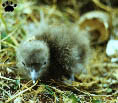 Long-tailed
Skua,
Long-tailed
Skua,
Pevek. |
Parasitic
Skua or Arctic Jaeger are amongst the most common
birds of prey
on the arctic tundra.
There are three species:
Stercorarius parasiticus, Arctic Skua / Parasitic Jaeger
Stercorarius longicaudus, Long-tailed Skua / Jaeger
Stercorarius pomarinus, Pomarine Skua / Jaeger
|
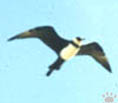 Pomarine
Skua
Pomarine
Skua
Kapp Schmidt. |
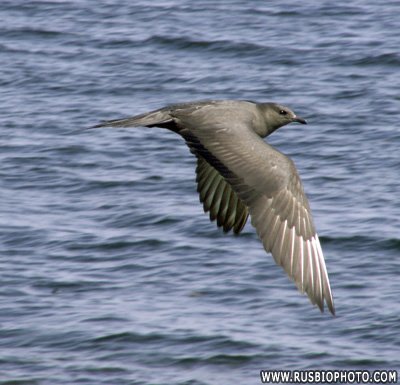
Long-tailed
Skua / Jaeger,
Stercorarius longicaudus
©
www.ecosystema.ru/
Of the three species, it is the long-tailed
skua that is most dependent on lemmings, and the number of this
bird is
varying in largely.. The long-tailed skua likes eggs and chickes
during summer. All three birds are wellknown thieves of food
from other seabirds.
Forest of the Tundra
The western part of Chukotka few forests, and
they consist first of all of Dahuria-lerk og furubusker, Pinus
pumila,
og - i elvedalene - vierkratt, Chosenia arbutifolia og
popler - poplar (Populus suaveolensis
-. Men elvedalene har selvfølgelig enda mere å
vise til.

Av
alle Kamchatkas skoger, fortjener
sibirsk dvergfuru, Pinus pumila spesiell oppmerksomhet.
Nøttene (frøene) fra dens kongler er ikke
så store som hos sibirfuru, Pinus sibirica, men
desto sunnere;
de blir kraftig høstet og bruk i matveien. Olje
presses ut og er en viktig eksportartikkel
Photo
courtesy: http://www.kamchatka.org.ru
|
Pinus pumila (also known as the Siberian dwarf pine, Dwarf Siberian
Pine, Japanese stone pine or Creeping pine) is a
native to northeastern Asia, including the islands of Japan.
This shrubby pine ranges from 1–3 m in height, exceptionally
up to 5 m, but may have individual branches that extend farther
along the ground in length. In the mountains of northern
Japan, it sometimes hybridises with the related Japanese White
Pine (Pinus parviflora); these hybrids (Pinus x hakkodensis)
are larger than P. pumila, reaching 8–10 m tall on occasion.
|
 
Nøttekråke,Nucifraga
caryocatactes Gråsisik,
Acanthis flammea
©
www.ecosystema.ru/
The most common animals here are Brown
Bear, Ursus arctos, Canadian
Moose, Alces canadensis,Wolverine,
Sobel,
Martes zibellina,
Hare, småmus, Golden
Eagle , Aquila chrysaetos, Northern
Goshawk, Accipiter gentilis, Scoter, Melanitta,
Magpie,
Pica pica, Spotted
Nutcracker, Nucifraga caryocatactes, Wagtails,
Motacilla,
Common
Redpoll , Acanthis flammea, Warblers,
Phylloscopus, larks,
Anthus og Bluethroat,
Luscinia svecica. |

Buethroat,
Luscinia svecica
©
www.ecosystema.ru/

Rivers and lakes.
Rivers and lakes. Chukotka’s larger rivers are the Anadyr,
Amguema, Greater Anyui, Lesser Anyui, and Omolon.
The rivers freeze over completely, with ice covering them up
to eight months a year, and large ice floes at higher elevations
do not melt for years. Snowmelt is the primary source of water
for these Arctic rivers, with precipitation and groundwater
as lesser secondary sources. Groundwater, surface water, and
precipitation feed the rivers that fl ow into the Pacific.
Riverbeds are rocky with little sediment.
The only amphibian is Siberian salamander, Salamandrella
kesserlingii, found in shallow lakes of the south and west. |
Siberian
salamander, Salamandrella keyserlingii,
 Photo: S.L Kuzmin,
© PENSOFT Publishers
Photo: S.L Kuzmin,
© PENSOFT Publishers |
The Siberian salamander, Salamandrella keyserlingii,
is a species of salamander found in Northeast Asia.
It is found primarily in Siberia, in wet woods and riparian
groves. There are also outlying populations in northern Kazakhstan
and Mongolia, and also in northeastern China and on the Korean
Peninsula. It is believed extirpated from South Korea.
An isolated population exists on Hokkaido, Japan, in the Kushiro
Shitsugen National Park. A breeding-ground of Siberian salamanders
in Paegam, South Hamgyong, is designated North Korean natural
monument #360.
Adults are from 9 to 12.5 centimeters in length. Their bodies
are bluish-brown in color, with a purple stripe along the
back. There are thin dark brown stripes between and around
the eyes, and also sometimes on the tail. There are four clawless
toes on each foot. The tail is longer than the body.
A single egg sac contains 50-80 eggs on average, with a single
female typically laying up to 240 eggs in a season. The light-brown
eggs hatch three to four weeks after being laid, releasing
larval salamanders of 11-12 mm in length.
The species is known for surviving deep freezes, as low as
-35 - -40o°C. In some cases they have been known to remain
frozen in permafrost for years, and upon thawing, walking
off.
|
44 different fishes lives in rivers and lakes. Salmon is the one
used mostly for commercial use.
Twohundredandtwenty - 220 - birdspecies also live hiere.
Pacific
Walrus,
Odobenus rosmarus divergens

 
Center:
Wallruses at Cape Dezhnyov, Bering Strait, Chukotka
Two
other pictures: USGS
The star attraction is no doubt the
Pacific Walrus, Odobenus
rosmarus divergens. Unlike the other two sub-species, som
that mainly stays on ice-flakes, this one prefer to invade beaches
in large numbers.
You can find many such places in Chukotka during the summer,
and also at a few hideout places in Alaska.
During winter they occur in the Eastern Kamchatka and on the
Commandor Islands. |

©
www.ecosystema.ru/
The Walrus is distinct from the earseals and the 'true seals', having
its own familyname with only one living specimen.
But there are two subspecimens::
Pacific Walrus, Odobenus rosmarus divergens
Atlantic Walrus, Odobenus rosmarus rosmarus
More
about Walrusses, click here
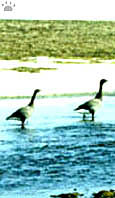 Black
brants,
Black
brants,
Anser nigricans,
begynner redebygging
tidlig om våren.
Dixon, Taimyr. |
During autumnm many birds leave these northern areas.
A few specimees, as McKay's bunting
(P. mckayi), moves actually to
Chukotka for the winter.. Black brants
moves from their arctic places to their winterhabitat in
America.
The Black Brant or Pacific Brent Goose, Branta
bernicla nigricans, is a
sub-species of the Brent Goose that breeds in Alaska and
winters in Baja
California. There are an estimated 115,000 black brant in
the world and
about 14,000 are taken each year by hunters. Fox predation
of eggs is
thought to be significant and, in 2006, the U.S. began a
5-year fox removal
program. The population has been as high as 200,000; in
1981, and as low
as 100,000; in 1987.
http://en.wikipedia.org/wiki/Black_Brant
|
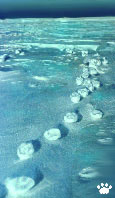 Vindskulpturer
på spor etter Polarreven
Vindskulpturer
på spor etter Polarreven
(Vulpes lagopus),
Amderma, Russia. |
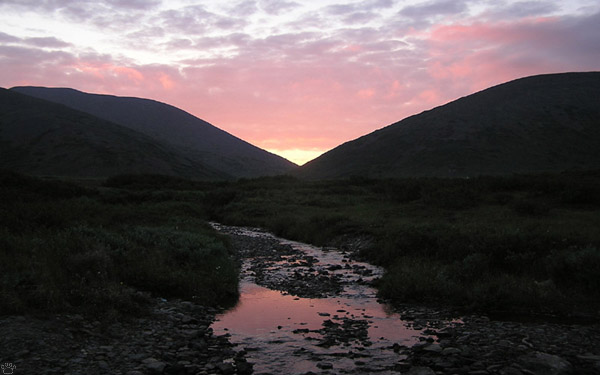 Sommernatt
i Dionisiafjellene, Chukotka, Russia.
Sommernatt
i Dionisiafjellene, Chukotka, Russia. |
Part 2.
Back to menu
All
pictures, unless otherwise stated, Copyright © Vladimir
Dinets
Source for part of this page: http://urbansustainability.snre.umich.edu/wp-content/uploads/2011/04/RFE.08.pdf
|
























